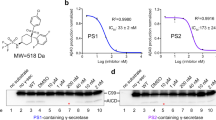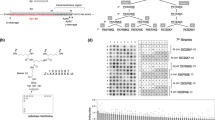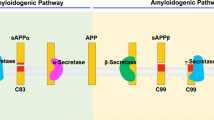Abstract
The β-amyloid precursor protein (β-APP), which is involved in the pathogenesis of Alzheimer’s disease, and the Notch receptor, which is responsible for critical signalling events during development, both undergo unusual proteolysis within their transmembrane domains by unknown γ-secretases. Here we show that an affinity reagent designed to interact with the active site of γ-secretase binds directly and specifically to heterodimeric forms of presenilins, polytopic proteins that are mutated in hereditary Alzheimer’s and are known mediators of γ-secretase cleavage of both β-APP and Notch. These results provide evidence that heterodimeric presenilins contain the active site of γ-secretase, and validate presenilins as principal targets for the design of drugs to treat and prevent Alzheimer’s disease.
This is a preview of subscription content, access via your institution
Access options
Subscribe to this journal
Receive 12 print issues and online access
$209.00 per year
only $17.42 per issue
Buy this article
- Purchase on Springer Link
- Instant access to full article PDF
Prices may be subject to local taxes which are calculated during checkout








Similar content being viewed by others
References
Hardy, J. The Alzheimer family of diseases: many etiologies, one pathogenesis? Proc. Natl Acad. Sci. USA 94, 2095–2097 (1997).
Selkoe, D. J. Alzheimer’s disease: genotypes, phenotypes and treatments. Science 275, 630–631 ( 1997).
Selkoe, D. J. Translating cell biology into therapeutic advances in Alzheimer’s disease . Nature 399 A23–A31 (1999).
Vassar, R. et al. beta-secretase cleavage of Alzheimer’s amyloid precursor protein by the transmembrane aspartic protease BACE. Science 286, 735–741 (1999).
Sinha, S. et al. Purification and cloning of amyloid precursor protein beta-secretase from human brain. Nature 402, 537–540 (1999).
Yan, R. et al. Membrane-anchored aspartyl protease with Alzheimer’s disease beta-secretase activity. Nature 402, 533 –537 (1999).
Hussain, I. et al. Identification of a novel aspartic protease (Asp2) as beta-secretase . Mol. Cell Neurosci. 14, 419– 427 (1999).
Lichtenthaler, S. F. et al. Mechanism of the cleavage specificity of Alzheimer’s disease gamma-secretase identified by phenylalanine-scanning mutagenesis of the transmembrane domain of the amyloid precursor protein. Proc. Natl Acad. Sci. USA 96, 3053–3058 (1999).
Wolfe, M. S. et al. Peptidomimetic probes and molecular modeling suggest Alzheimer’s γ-secretases are intramembrane-cleaving aspartyl proteases. Biochemistry 38, 4720–7 (1999).
Buxbaum, J. D. et al. Evidence that tumor necrosis factor α converting enzyme is involved in regulated α-secretase cleavage of the Alzheimer’s amyloid protein precursor. J. Biol. Chem. 273, 27765–27767 (1998).
Brou, C. et al. A novel proteolytic cleavage involved in Notch signaling: the role of the disintegrin-metalloprotease TACE. Mol. Cell 5, 207–216 (2000).
De Strooper, B. et al. A presenilin-1-dependent γ-secretase-like protease mediates release of Notch intracellular domain. Nature 398, 518–522 (1999).
Schroeter, E. H., Kisslinger, J. A. & Kopan, R. Notch-1 signalling requires ligand-induced proteolytic release of intracellular domain. Nature 393, 382–386 (1998).
De Strooper, B. et al. Deficiency of presenilin-1 inhibits the normal cleavage of amyloid precursor protein. Nature 391, 387 –390 (1998).
Li, X. & Greenwald, I. Membrane topology of the C. elegans SEL-12 presenilin. Neuron 17, 1015– 1021 (1996).
Li, X. & Greenwald, I. Additional evidence for an eight-transmembrane-domain topology for Caenorhabditis elegans and human presenilins. Proc. Natl Acad. Sci. USA 95, 7109–7114 (1998).
Sherrington, R. et al. Cloning of a gene bearing missense mutations in early-onset familial Alzheimer’s disease. Nature 375, 754–760 (1995).
Wolfe, M. S. et al. Two transmembrane aspartates in presenilin-1 required for presenilin endoproteolysis and γ-secretase activity. Nature 398, 513–517 ( 1999).
Leimer, U. et al. Zebrafish (Danio rerio) presenilin promotes aberrant amyloid beta- peptide production and requires a critical aspartate residue for its function in amyloidogenesis. Biochemistry 38 , 13602–13609 (1999).
Steiner, H. et al. A loss of function mutation of presenilin-2 interferes with amyloid beta-peptide production and Notch signaling. J. Biol. Chem. 274, 28669–28673 ( 1999).
Kimberly, W. T., Xia, W., Rahmati, T., Wolfe, M. S. & Selkoe, D. J. The transmembrane aspartates in presenilin 1 and 2 are obligatory for gamma-secretase activity and amyloid beta-protein generation . J. Biol. Chem. 275, 3173–3178 (2000).
Ray, W. J. et al. Cell surface presenilin-1 participates in the gamma-secretase-like proteolysis of Notch. J. Biol. Chem. 274, 36801–36807 (1999).
Berezovska, O. et al. Two transmembrane aspartate mutations in presenilin impair Notch 1 proteolysis and nuclear translocation, with relative preservation of Notch signaling. J. Neurochem. (in the press).
Wolfe, M. S. et al. A substrate-based difluoro ketone selectively inhibits Alzheimer’s γ-secretase activity. J. Med. Chem. 41, 6– 9 (1998).
Tischer, E. & Cordell, B. Beta-amyloid precursor protein. Location of transmembrane domain and specificity of gamma-secretase cleavage. J. Biol. Chem. 271, 21914–21919 (1996).
Maruyama, K. et al. Familial Alzheimer’s disease-linked mutations at Val717 of amyloid precursor protein are specific for the increased secretion of A beta 42(43). Biochem. Biophys. Res. Commun. 227, 730–735 (1996).
Lichtenthaler, S. F., Ida, N., Multhaup, G., Masters, C. L. & Beyreuther, K. Mutations in the transmembrane domain of APP altering gamma-secretase specificity. Biochemistry 36, 15396–15403 (1997).
Wolfe, M. S. et al. Peptidomimetic probes suggest a large S1 pocket for Alzheimer’s γ-secretase . Soc. Neurosci. 25, abstract 122.3 (1999).
Atlas, D., Steer, M. L. & Levitzki, A. Affinity label for beta-adrenergic receptor in turkey erythrocytes. Proc. Natl Acad. Sci. USA 73, 1921–1925 (1976).
Kohrle, J. et al. Affinity labeling of rat liver and kidney type I5′-deiodinase. Identification of the 27-kDa substrate binding subunit. J. Biol. Chem. 265, 6155–6163 ( 1990).
Smar, M. W. et al. Selective irreversible inhibitors of aldose reductase. J. Med. Chem. 35, 1117–1120 (1992).
Thinakaran, G. et al. Endoproteolysis of presenilin 1 and accumulation of processed derivatives in vivo. Neuron 17, 181 –190 (1996).
Podlisny, M. B. et al. Presenilin proteins undergo heterogeneous endoproteolysis between Thr291 and Ala299 and occur as stable N- and C-terminal fragments in normal and Alzheimer brain tissue. Neurobiol. Dis. 3 325–337 (1997).
Capell, A. et al. The proteolytic fragments of the Alzheimer’s disease-associated presenilin-1 form heterodimers and occur as a 100-150-kDa molecular mass complex . J. Biol. Chem. 273, 3205– 3211 (1998).
Thinakaran, G. et al. Evidence that levels of presenilins (PS1 and PS2) are coordinately regulated by competition for limiting cellular factors. J. Biol. Chem. 272, 28415–28422 ( 1997).
Yu, G. et al. The presenilin 1 protein is a component of a high molecular weight intracellular complex that contains beta-catenin. J. Biol. Chem. 273, 16470–16475 (1998).
Xia, W. et al. Presenilin complexes with the C-terminal fragments of Amyloid Precursor Protein at the sites of Amyloid β-protein generation. Proc. Natl Acad. Sci. USA (in the press).
Ratovitski, T. et al. Endoproteolytic processing and stabilization of wild-type and mutant presenilin. J. Biol. Chem. 272, 24536–24541 (1997).
Selkoe, D. J. Notch and presenilins in vertebrates and invertebrates: implications for neuronal development and degeneration. Curr. Opin. Neurobiol. 10, 50–57 (2000).
Herreman, A. et al. Presenilin 2 deficiency causes a mild pulmonary phenotype and no changes in amyloid precursor protein processing but enhances the embryonic lethal phenotype of presenilin 1 deficiency. Proc. Natl Acad. Sci. USA 96, 11872–11877 ( 1999).
Struhl, G. & Greenwald, I. Presenilin is required for activity and nuclear access of Notch in Drosophila. Nature 398, 522–525 (1999).
Ye, Y., Lukinova, N. & Fortini, M. E. Neurogenic phenotypes and altered Notch processing in Drosophila presenilin mutants. Nature 398, 525–529 (1999).
Fehrentz, J-A. & Castro, B. An efficient synthesis of optically active α-(t-butoxycarbonylamino)-aldehydes from α-amino acids. Synthesis 1983, 676–678 (1983).
Koo, E. H. & Squazzo, S. L. Evidence that production and release of amyloid beta-protein involves the endocytic pathway. J. Biol. Chem. 269, 17386–17389 ( 1994).
Xia, W. et al. Presenilin 1 regulates the processing of beta-amyloid precursor protein C-terminal fragments and the generation of amyloid beta-protein in endoplasmic reticulum and Golgi. Biochemistry 37, 16465–16471 (1998).
Haass, C. et al. Amyloid beta-peptide is produced by cultured cells during normal metabolism. Nature 359, 322– 325 (1992).
Xia, W., Zhang, J., Perez, R., Koo, E. H. & Selkoe, D. J. Interaction between amyloid precursor protein and presenilins in mammalian cells: implications for the pathogenesis of Alzheimer disease. Proc. Natl Acad. Sci. USA 94, 8208 –8213 (1997).
Acknowledgements
We thank D. Miller and D. Walsh for helpful discussions, W. Ye for help with cell cultures, J. Shen for providing PS1–/– mouse fibroblasts, S. Gandy for antibody Ab14, C. Haass for antibody 2972 and T. Iwatsubo for antibody PS2L. This work was supported by NIH grants NS37537 (to M.S.W.) and AG12749 (to D.J.S.) and by a Pioneer Award from the Alzheimer’s Association (to D.J.S.).
Correspondence and requests for materials should be addressed to M.S.W.
Author information
Authors and Affiliations
Corresponding author
Rights and permissions
About this article
Cite this article
Esler, W., Kimberly, W., Ostaszewski, B. et al. Transition-state analogue inhibitors of γ-secretase bind directly to presenilin-1. Nat Cell Biol 2, 428–434 (2000). https://doi.org/10.1038/35017062
Received:
Revised:
Accepted:
Published:
Issue Date:
DOI: https://doi.org/10.1038/35017062
This article is cited by
-
Enzyme-substrate hybrid β-sheet controls geometry and water access to the γ-secretase active site
Communications Biology (2023)
-
γ-Secretase in Alzheimer’s disease
Experimental & Molecular Medicine (2022)
-
Targeting γ-secretase for familial Alzheimer’s disease
Medicinal Chemistry Research (2021)
-
Substrate-based chemical probes for Alzheimer’s γ-secretase
Medicinal Chemistry Research (2020)
-
Dysfunctional γ-Secretase in Familial Alzheimer’s Disease
Neurochemical Research (2019)



